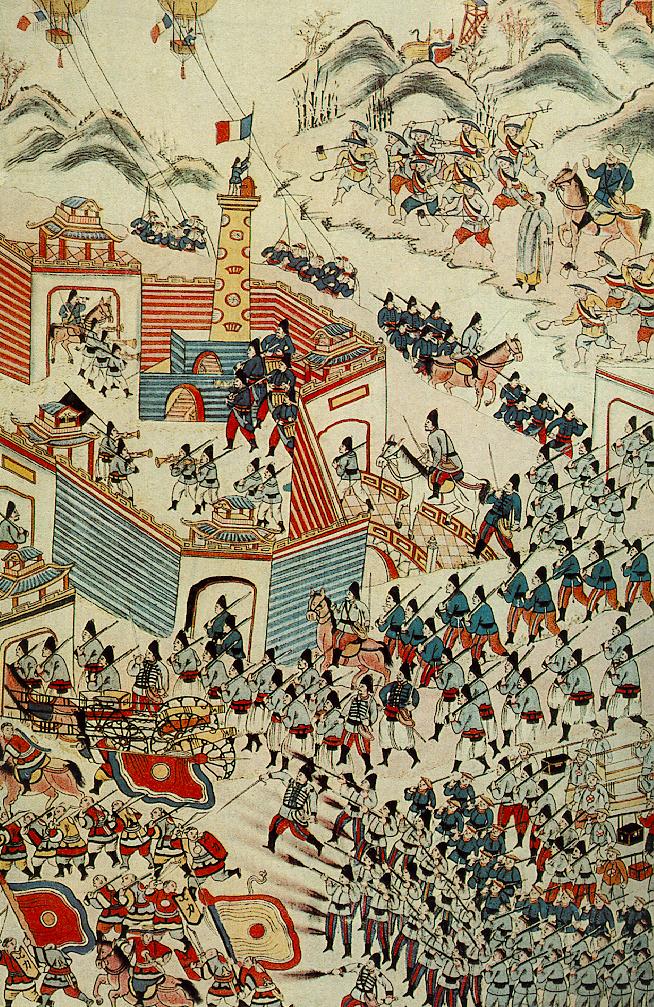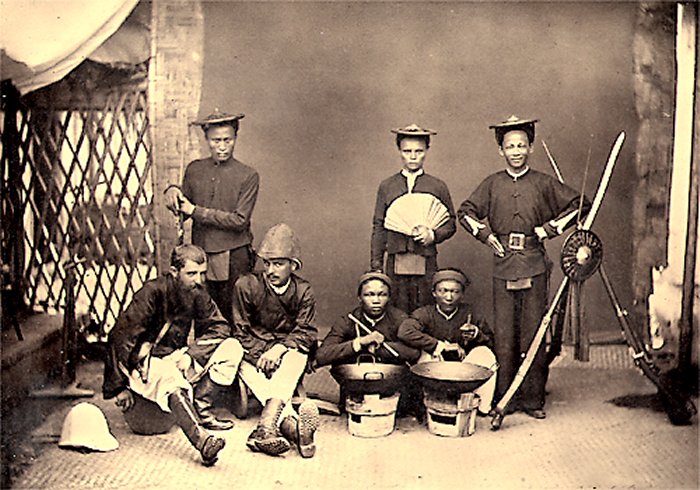|
Battle Of Hòa Mộc
The Battle of Hòa Mộc (2 March 1885) was the most fiercely fought action of the Sino-French War (August 1884 – April 1885). At heavy cost, Colonel Giovanninelli's 1st Brigade of the Tonkin Expeditionary Corps defeated forces of the Black Flag and Yunnan Armies blocking the way to the besieged French post of Tuyên Quang. Background The French capture of Lạng Sơn in February 1885 in the Lạng Sơn Campaign allowed substantial French forces to be diverted further west to relieve the small and isolated French garrison in Tuyên Quang, which had been placed under siege in November 1884 by Liu Yongfu(劉永福)'s Black Flag Army and Tang Jingsong(唐景崧)'s Yunnan Army. The Siege of Tuyên Quang was the most evocative confrontation of the Sino-French War. The Chinese and Black Flags sapped methodically up to the French positions, and in January and February 1885 breached the outer defences with mines and delivered seven separate assaults on the breach. The Tuyên Quang gar ... [...More Info...] [...Related Items...] OR: [Wikipedia] [Google] [Baidu] |
Sino-French War
The Sino-French War (, french: Guerre franco-chinoise, vi, Chiến tranh Pháp-Thanh), also known as the Tonkin War and Tonquin War, was a limited conflict fought from August 1884 to April 1885. There was no declaration of war. The Chinese armies performed better than its List of Chinese wars and battles#Qing dynasty (1644–1912), other nineteenth-century wars and the war ended with French retreat on land and the momentum in China's favor. However lack of foreign support, French naval supremacy, and northern threats posed by Russia and Japan forced China to enter negotiations. China ceded its sphere of influence in Tonkin (northern Vietnam) to France and recognized all the French treaties with Annam (French protectorate), Annam turning it into a French protectorate. The war strengthened the dominance of Empress Dowager Cixi over the Chinese government, but brought down the government of Prime Minister Jules Ferry in Paris. Both sides ratified the Treaty of Tientsin (1885), Trea ... [...More Info...] [...Related Items...] OR: [Wikipedia] [Google] [Baidu] |
Hưng Hóa
Thành Hưng Hóa was a fort and settlement in present-day Phú Thọ Province, northern Vietnam.''Tradition, Revolution, and Market Economy in a North ...'' Hy V. Luong - 2010 - Page 37 " ... route of attack and counterattack between the French-controlled town of Hưng-Hoá and the major guerrilla base of Thanh-Mai " The capture of Hưng Hóa in 1884 was an important French victory in the Tonkin Campaign The Tonkin campaign was an armed conflict fought between June 1883 and April 1886 by the French against, variously, the Vietnamese, Liu Yongfu's Black Flag Army and the Chinese Guangxi and Yunnan armies to occupy Tonkin (northern Vietnam) and .... References {{DEFAULTSORT:Hung Hoa French Indochina ... [...More Info...] [...Related Items...] OR: [Wikipedia] [Google] [Baidu] |
Hoa Moc
The Hoa people (Vietnamese: ''Người Hoa'', or ) are citizens of Vietnam of full or partial Chinese origin. Chinese migration into Vietnam dates back millennia but most Hoa today derive their recent ancestral Chinese heritage from the 18th century, especially from southern Chinese provinces. They are an ethnic minority group in Vietnam and a part of the overseas Chinese community and can be found in the Americas. They may also be called "Chinese-Vietnamese" or "Chinese people living in/from Vietnam" by the Vietnamese, Chinese diaspora and Overseas Vietnamese. Historically, ancient Chinese brought cultural, religious and philosophical thought to Vietnam, where the Vietnamese gradually developed and adapted on its own. Beginning as early as the 19th century, the Hoa people were known during the French colonial rule for collaborating with the French in heavily exploiting and taking Vietnamese resources. Despite this, the Hoa community still exists in contemporary Vietnamese so ... [...More Info...] [...Related Items...] OR: [Wikipedia] [Google] [Baidu] |
Tonkinese Rifles
The Tonkinese Rifles (''tirailleurs tonkinois'') were a corps of Tonkinese light infantrymen raised in 1884 to support the operations of the Tonkin Expeditionary Corps. Led by French officers seconded from the marine infantry, Tonkinese riflemen fought in several engagements against the Chinese during the Sino-French War and took part in expeditions against Vietnamese insurgents during the subsequent French Pacification of Tonkin. The French also organized similar units of indigenous riflemen from Annam and Cambodia. All three categories of indigenous soldiers were known in Vietnam as Lính tập. Background During the campaigns of Francis Garnier in Tonkin in 1873 the French raised irregular units of Tonkinese militiamen, many of them Christians who felt little loyalty to the brutal regime of Tự Đức. These units existed for only a few weeks, and were disbanded when the French withdrew from Tonkin in the spring of 1874, but the experiment demonstrated the potential for the r ... [...More Info...] [...Related Items...] OR: [Wikipedia] [Google] [Baidu] |
Turcos At Hoa Moc
A tirailleur (), in the Napoleonic era, was a type of light infantry trained to skirmish ahead of the main columns. Later, the term "''tirailleur''" was used by the French Army as a designation for indigenous infantry recruited in the French colonial territories during the 19th and 20th centuries, or for metropolitan units serving in a light infantry role. The French army currently maintains one tirailleur regiment, the '' 1er régiment de tirailleurs''. This regiment was known as the 170th infantry regiment between 1964 and 1994. Prior to 1964, it was known as the ''7e régiment de tirailleurs algériens'', but changed its name after it moved to France as a result of Algerian independence. History Napoleonic period In the wars of the French Revolutionary and Napoleonic periods, the designation "tirailleur" was a French military term used at first to refer generically to light infantry skirmishers. The first regiments of Tirailleurs so called were part of the Imperial G ... [...More Info...] [...Related Items...] OR: [Wikipedia] [Google] [Baidu] |
Battle Of Palan
The Battle of Palan (1 September 1883) was one of several clashes between the Tonkin Expeditionary Corps and Liu Yongfu's Black Flag Army during the Tonkin campaign (1883–1886). Background The Battle of Palan was fought two weeks after the Battle of Phủ Hoài, in which General Alexandre-Eugène Bouët (1833–87), the French ''commandant supérieur'' in Tonkin, had failed to defeat Liu Yongfu's Black Flag Army. Heavy flooding in mid-August had obliged the Black Flags to abandon their positions in front of the Day River and retreat behind the river. The key to their new positions were the villages of Phong (or Phung), commanding the main road to Sơn Tây at its crossing of the Day River, and Palan (also known as Ba Giang), at the junction of the Red and Day rivers. Under pressure from Jules Harmand, the French civil commissioner general in Tonkin, Bouët attacked the new Black Flag positions at the end of August to clear the road to Sơn Tây, the ultimate French objective ... [...More Info...] [...Related Items...] OR: [Wikipedia] [Google] [Baidu] |
劉永福
Liu Yongfu () (1837–1917) was a Chinese warlord and commander of the celebrated Black Flag Army. Liu won fame as a Chinese patriot fighting against the French Empire in northern Vietnam (Tonkin) in the 1870s and early 1880s. During the Sino-French War (August 1884–April 1885), he established a close friendship with the Chinese statesman and general Tang Jingsong, and in 1895, he helped Tang organise resistance to the Japanese invasion of Taiwan. He succeeded Tang as the second and last president of the short-lived Republic of Formosa (5 June–21 October 1895). Early years Liu Yongfu was born on 10 October 1837, in the town of Qinzhou (Ch'in-chou, 欽州) in southern China, close to the Vietnamese border. Qinzhou, now in Guangxi province, was at that time in the extreme southwest of Guangdong province. The ancestral home of Liu's family was the village of Popai in Guangxi province, and when he was eight his parents moved to Shangsizhou (Shang-ssu-chou, 上思州) in Guangx ... [...More Info...] [...Related Items...] OR: [Wikipedia] [Google] [Baidu] |
Battle Of Yu Oc
The Battle of Yu Oc (19 November 1884) was a French victory during the Sino-French War. The battle was fought to relieve the French garrison of Tuyên Quang, under siege by the Tang Jingsong's Yunnan Army and Liu Yongfu's Black Flag Army. The French commander at Yu Oc, Colonel Jacques Duchesne, would later distinguish himself as the conqueror of Madagascar (1895). Background The French installed a post at Tuyên Quang in June 1884, in the wake of their capture of Hưng Hóa and Thái Nguyên. Tuyên Quang, an isolated settlement on the Clear River, was the most westerly French outpost in Tonkin, and was more than away from the French garrisons in Hưng Hóa and Thái Nguyên. During the summer and autumn of 1884 the post was garrisoned by two companies of the 1st Battalion, 1st Foreign Legion Regiment (Captains Chmitelin and Broussier), under the command of ''chef de bataillon'' Frauger. The outbreak of the Sino-French War on 23 August 1884 exposed the post to attack by Ta ... [...More Info...] [...Related Items...] OR: [Wikipedia] [Google] [Baidu] |
Jacques Duchesne
General Jacques Charles René Achille Duchesne (3 March 1837 – 27 April 1918) was a 19th-century French military officer. He was born at Sens and entered École spéciale militaire de Saint-Cyr, Saint-Cyr in 1855, aged 18, and became a lieutenant in 1861. Career Duchesne fought in the Franco-Prussian War in 1870–1871."He distinguished himself in the Franco-Prussian war, 1870-71" in ''The International Cyclopedia: A Compendium of Human Knowledge'' by Selim Hobart Peabody, Charles Francis Richardson – Encyclopedias and dictionaries (1898), p. 147 He became a lieutenant-colonel in 1881. Tonkin and Formosa In 1884-85, during the Sino-French War, Lieutenant-Colonel Duchesne distinguished himself both in Tonkin (northern Vietnam) and Formosa (now Taiwan). On 12 March 1884, during the Bắc Ninh Campaign, Duchesne was placed by General François de Négrier in command of the 2nd Brigade's attack on the forward defences of Bắc Ninh and led a successful charge into the Chinese-h ... [...More Info...] [...Related Items...] OR: [Wikipedia] [Google] [Baidu] |
Phu An Binh
Phu or ''variation'', may refer to: Places *Phủ, prefecture in 15th–19th century Vietnam People Given name *Phu Dorjee (died 1987), first Indian to climb Mount Everest without oxygen *Phu Dorjee Sherpa (died 1969), first Nepali to climb Mount Everest *Phu Lam (1961–2014), perpetrator in the 2014 Edmonton killings *Trần Phú (1904–1931), Vietnamese communist revolutionary *Trương Phụ (1375–1449), general of the Ming Dynasty of China Surname *Charles Phu, architect and set designer *Phu Pwint Khaing (born 1987), Burmese soccer player *Sunthorn Phu (1786–1855), Siamese poet Linguistics *Phuan language (ISO 639 language code: phu) *Phu Thai language, the Phu language of Thais *Nar Phu language, the Nar and the Phu languages Other uses * Public Health Units of Ontario, Canada *Pannon Air Service (ICAO airline code: PHU), see List of airline codes (P) See also * * Phoo * Foo (other) * Fu (other) Fu or FU may refer to: In arts and entertainm ... [...More Info...] [...Related Items...] OR: [Wikipedia] [Google] [Baidu] |







